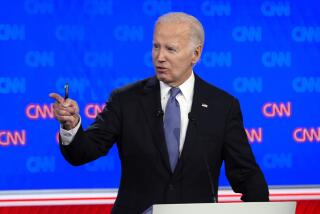Column: ‘Quiet quitting’ is just a new name for an old reality

- Share via
Many years ago, when I was just starting my career as a daily newspaper reporter for pay, my youthful colleague and I had a remedy for the occasional feelings of burnout we all experienced.
We would call in sick when we weren’t, you know, really sick. We called this, with a wink among ourselves, “taking a mental health day.”
Imagine my surprise to discover that I was decades ahead of the times. What I was doing then was “quiet quitting.”
Your worth as a person is not defined by your labor.
— TikTok user zaidleppelin
You may have heard the term lately because it’s all over the place. Typically, it’s associated with worker anomie, or ennui, or burnout.
The idea is that employees who are exhausted or frustrated by ever-increasing duties and ever-longer demands on their time and are feeling unappreciated ratchet back to the bare minimum of their job duties.
Get the latest from Michael Hiltzik
Commentary on economics and more from a Pulitzer Prize winner.
You may occasionally receive promotional content from the Los Angeles Times.
Perhaps they look around the work floor and their eyes settle on those co-workers who never seem to be carrying their weight, increasing the burden on everyone else. Or, resenting managements that exploit them but don’t reward them, they resolve to join the legion of timeservers and clock-watchers.
They say they’ll work 9 to 5, but not more. They won’t answer calls or emails from the boss after hours. They’ll take the weekends and vacations they’re entitled to.
Is there anything new about this? The answer is no, except for the term. Blogger Kevin Drum calls it “the latest half-witted workplace meme.” He’s right.
Supposedly the term was coined by a TikTok user who advised followers to stop “subscribing to the hustle-culture mentality that work has to be your life” and that “your worth as a person is not defined by your labor,” though in the TikTok he says he recently learned about the term, so plainly he isn’t the inventor.
To be clear, there’s nothing new about any of this. The Washington Post’s article this week about “quiet quitting” acknowledged so much, quoting a life coach admitting that it’s “a new term for an old concept.”
Indeed, one can find any number of old terms for the old concept. “Work-life balance” has been a perennial pursuit in the workforce.
Unions in contract negotiations have historically imposed “work to rule” initiatives, in which members refuse the myriad little accommodations that employers sometimes ask for — declining overtime, for instance. (When police union members take sick days to put pressure on their cities, it’s known as the “blue flu.”)
They’re the antecedents of “quiet quitting.”
The problem with attaching a new name to the old concept is that it implies that the concept is novel or more widespread than it really is. This is the same phenomenon one sees in labeling campaigns such as the attack on “critical race theory,” or CRT, in schools, or the “death panels” meme that was used to undermine the Affordable Care Act.
In truth, CRT is not being taught in primary schools in the U.S. and “death panels” were a fabricated description of the treatment judgments that are part of normal healthcare. But putting a name to the concepts sure made them seem like fundamental threats to American life, didn’t it?
“ESG” — shareholder pressure on corporate managements over “environmental, social and governance” issues, is another target acronym.
Florida Gov. Ron DeSantis, who has also waved the CRT flag to burnish his standing as a culture warrior, leaned on the board overseeing the state’s pension portfolio not to consider “the ideological agenda of the environmental, social, and corporate governance (ESG) movement” when evaluating investments.
The board, being spineless, assented. Meanwhile, investment promoters are beginning to think of ways to rebrand ESG investment funds so that people like DeSantis will have to find some other rubric to grouse about.
Another workplace meme worth questioning — and related to “quiet quitting” — is the “Great Resignation” of 2021-22. This applies to the purportedly unprecedented overt quitting of jobs during the economic recovery from the pandemic.
The Great Resignation has sometimes been described as a unique phenomenon caused by workers’ recognition during the pandemic that they were underappreciated and underpaid, which spawned a movement to better their working conditions.
It’s true that voluntary “quits” reached something of a peak in April 2021, as the economy began to reopen and the post-pandemic recovery began, reaching 3% of total nonfarm employment in November and December 2021. But it has come down since then; the rate in June was unchanged from that in June 2021.

Nor are surges in resignations unusual during rapid recoveries, such as the post-pandemic period, according to Bart Hobijn of Arizona State University and the Federal Reserve Bank of San Francisco.
Hobijn casts doubt on the notion that the U.S. has experienced “a wave of people reconsidering their career prospects ... and ultimately resigning in such numbers that it is drastically altering the labor supply in the wake of the pandemic.”
Waves of similar magnitude occurred in 1948, 1951, 1953, 1966, 1969, and 1973, Hobijn shows — all periods of rapid employment growth, like now.
He finds that the Great Resignation chiefly occurred among younger and less-educated workers, especially in retail and hospitality jobs, which were among the hardest-hit during the pandemic and have recovered speedily.
“There was not a particularly large increase in the share of job quitters that changed either industry of employment or occupation,” Hobijn writes. “Such an increase would be expected if the current wave involved a broad reconsideration of career choices.”
Instead, it appears to reflect a quest for higher wages for the same jobs.
Articles about “quiet quitting” strive to bring the concept up to date by asserting that it’s happening today, when “burnout is at an all-time high,” as the Washington Post put it.
Is that so, however? There’s no empirical evidence for the claim. Some human resources consulting firms cite polls finding that lots of workers are feeling burned out, but it’s hard to find any that track the phenomenon over time.
Thrivemyway, an advice site for digital entrepreneurs, says that “two-thirds of full-time employees say they have experienced burnout at some point in their careers, ... workplace burnout is becoming increasingly more common; [and] 36% of workers state that their organizations have nothing in place to help stave off employee burnout.”
Points one and three sound plausible, but what supports point two? Anyway, if the time frame is “some point in their careers,” it’s a little surprising that the figure isn’t 100%.
It’s quite understandable that more workers today feel that they’re laboring under greater pressure from employers. They tend to be in nonprofessional or nonsupervisory jobs that are subject to intrusive workplace surveillance — truck drivers, warehouse workers and others operating on tight schedules with high production quotas or those in jobs with high security demands.
Here and there, higher-paid professionals have rebelled at workplace pressures. One of the oddest such cases occurred at the investment bank Goldman Sachs in March 2021, when a clutch of junior entry-level analysts demanded a relaxation in their punishing workloads. They weren’t “quiet quitting,” but openly complaining about workweeks averaging 105 hours (that is, 15 hours a day, seven days a week). But they were raising the specter of burnout.
One could sympathize with them, if not for the fact that they knew this was the drill going in, with an enormous pot of gold awaiting them at the other end if they managed to survive.
Starbucks baristas nationwide have scored unionization successes, and the company is fighting back
Bloomberg columnist Matt Levine, a former Goldman Sachs banker, called the complaints “pretty cheeky,” and noticed that despite their overwork, the analysts had managed to reduce their complaints into a Goldman Sachs-style PowerPoint presentation.
Goldman’s brass made sympathetic noises at the time, but this March told workers they were expected to report to the office at least five days a week. The company’s chief executive, David Solomon, called working from home an “aberration” and said that he would put a stop to it.
It’s reasonable to assume that younger, newer workers remain as willing as previous generations to suffer a certain level of indignity if they think it will place them in a better position for career advancement. It’s one thing to say you’re going to knock off at 5 p.m. on the dot or not answer your boss’ emails after hours, but another thing to do so if you know that when promotion or raise time comes around, you’ll be at the bottom of the list.
It’s fair to say that for some workers with little power in the workplace, conditions may be more punishing than ever. The answer in most cases is to unionize, a solution that has been expanding recently, though not as strongly as high-profile organizing victories at Starbucks and Amazon might suggest.
National Labor Relations Board statistics show that 43,150 workers won union representation elections in the first half of this year, up from 18,912 in the same period last year, but that’s still a gain of only 0.3% in the nation’s unionized workforce of 14 million. Overall, the number of wage and salary workers represented by unions fell by 241,000 last year, according to the Bureau of Labor Statistics, continuing a nearly unbroken trend dating from at least the 1970s, even though on average unionized workers today earn 16.6% more than nonunion labor.
Zephyr Teachout of Fordham Law School observed in a recent piece in the New York Review of Books that the technology allowing employers to keep workers under surveillance has improved to the point that for some workers it’s inescapable. But Teachout also recounts her experience as a personal assistant to a rich writer living on Park Avenue whose intrusive treatment of Teachout and the other staff fostered intense paranoia. And that was nearly three decades ago.
None of this is likely to make the notion of “quiet quitting” disappear from social media, the airwaves and news pages; once a meme grabs hold, it can take time to dislodge it from public consciousness.
Putting a name to the phenomenon doesn’t make it any more real. Disaffected workers have always found ways to stick it to the Man, within limits. There’s no evidence that an unprecedented wave of such behavior is upon us, especially given that job creation is at the strongest level in years. Taking a day off or finding a new job is today, as it has always been, good for your mental health.
More to Read
Get the latest from Michael Hiltzik
Commentary on economics and more from a Pulitzer Prize winner.
You may occasionally receive promotional content from the Los Angeles Times.












